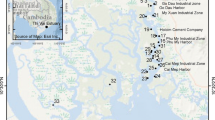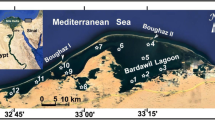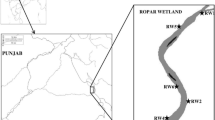Abstract
Diatom assemblages preserved in surface sediment are widely used for the bio-assessment of reservoirs and the present study is carried out to evaluate the distribution of diatom assemblages in reservoirs and potential of using diatom communities as indicators along with physical and chemical measurements from the reservoirs. Non-urban, shallow, small-scale reservoirs which span among three major climatic zones (Wet, Dry and Intermediate zones) were selected for the study. The present study reveals that most of the study reservoirs belong to the eutrophic category. From all the study reservoirs a total of 76 diatom taxa belonging to 46 genera were identified. Of these, the highest diversity was recorded from the Dry Zone. Aulacoseira granulata was the most dominant taxa whereas Achnanthidium, Pinnularia, Cymbella, Frustulia, Synedra, Eunotia, Nitzschia, Navicula, Cyclotella, Stauroneis and Gomphonema were also recorded at high abundane and widely distributed. The study reveals A. granulata, Achnanthidium, Nitzschia, Cyclotella and Diatoma inhabit in organically polluted eutrophic waters while Synedra acus, Synedra ulna and Amphora ovalis are the prime indicators of cultural eutrophication. Canonical correspondence analysis identified phosphate, dissolved oxygen, nitrite, conductivity and total dissolved solids as the most important measured environmental variables that could account for the distribution of diatom assemblages. However, the results of the present study reveal that the species distribution may depend on integration of a series of environmental variables and unmeasured environmental variables are also important in structuring diatom assemblages.



Similar content being viewed by others
References
Abeywickrama BA (1979) The genera of the freshwater algae of Sri Lanka. Part 1 UNESCO. In: Man and the biosphere national committee for Sri Lanka, special publications 6. National science council Sri Lanka, Colombo, pp 1–103
Alakananda B, Guruprasad S, Mahesh MK, Ramachandra TV (2010) Ecological characteristics of benthic diatom communities in assessment of lake trophic status. Lake 2010: wetlands, biodiversity and climate change. Energy and Wetlands Research Group, Centre for Ecological Sciences, Indian Institute of Science, Bengaluru, p 1
Anderson DS, Davis RB, Berge F (1986) Relationships between diatom assemblages in lake surface-sediments and limnological characteristics in southern Norway. In: Battarbee RW, Davis RB, Merilainen J, Smol JP (eds) Diatoms and lake acidity. Junk Publishers, Dordrecht, pp 97–113
Beres VB, Torok P, Kakai Z, Krasznai E, Tothmeresz B, Bacsi I (2014) Ecological diatom guilds are useful but not sensitive enough as indicators of extremely changing water regimes. Hydrobiologia 738:191–204
Clarke KR, Warwick RM (1994) Changes in marine communities: an approach to statistical analyses and interpretation. Natural Environment Research Council, Plymouth
Cooper SR (1999) Estuarine paleoenvironmental reconstructions using diatoms. In: Stoermer EF, Smol J (eds) The diatoms: application for the environmental and earth sciences. Cambridge University Press, Cambridge, pp 352–373
Davis RB, Anderson DS, Berge F (1985) Paleolimnological evidence that lake acidification is accompanied by loss of organic matter. Nature 316:436–438
Fabri R, L Leclercq (1984) Etude écologique des rivières du nord du massif Ardennais (Belgique): flore et végétation de diatomées et physico-chimie des eaux. 1. Contexte mésologique, méthodes, analyses physico-chimiques, synthèse taxinomique, écologique et floristique, iconographie, bibliographie. PhD thesis, Liège University, pp 379
Facca C, Sfriso A (2007) Epipelic diatom spatial and temporal distribution and relationship with the main environmental parameters in coastal waters. Estuar Coast Shelf Sci 75:35–49
Fernando CH (1990) The fresh water invertebrate fauna of Sri Lanka. In: Fernando CH (ed) Zoological survey of Sri Lanka: fresh water fauna and fisheries of Sri Lanka. Natural Resources, Energy and Science Authority of Sri Lanka, Colombo, pp 1–444
Gomez N, Riera JL, Sabater S (1995) Ecology and morphological variability of Aulacoseira granulata (Bacillariophyceae) in Spanish reservoirs. J Plankton Res 17:1–16
Jiang H, Seidenkrantza MS, Knudsena KL, Eiriksson J (2001) Diatom surface sediment assemblages around Iceland and their relationships to oceanic environmental variables. Marine Micropaleontol 41:73–96
Kilham SS, Kilham P (1975) Melosiragranulata (Ehr) Ralfs, morphology and ecology of a cosmopolitan freshwater diatom. Verh Ver Limnol 19:2716–2721
Kingston JE (1986) Diatom analysis-basic protocol. In: Charles DF, Whitehead DR (eds) Paleoecological investigation of recent lake acidification methods and project description, 6-1- 6-11.U.S. Electric Power Research Institute, Palo Alto
Kingston JC, Birks HJB (1990) Dissolved organic carbon reconstructions from diatom assemblages in PIRLA project lakes, North America. Philos Trans R Soc Lond B 327:279–288
Kouman KS, Stoilov GP, Docho DV (2001) The “nitrate nitrogen—electrical conductivity”. Relationship in non-saline soils under fertigation. Institute of Fruit Growing, Plovdiv
Krammer K, Lange-Bertalot H (1986–1991) Bacillariophyceae. In: Ettl H, Gerloff J, Heynig H, Mollenhauer D (eds) Susswasserflora von Mitteleuropa, vol 2(1–4). Gustav Fischer, Stuttgart/Jena
Lange-Bertalot H (1979) Pollution tolerance of diatoms as a criterion for water quality estimation. Nova Hedwig Beih 64:285–304
Leventer A, Dunbar RB (1996) Factors influencing the distribution of diatoms and other algae in the Ross Sea. J Geophys Res 101:18489–18500
Maishale DP, Ulavi S (2015) Bacillariophyceae as indictors of ecological status in Kabini River. IJSTE Int J Sci Technol Eng 2:76–82
Margalef R (1983) Limnología. Omega, Barcelona, p 1001
Patrick R, Reimer C (1966) The diatoms of the United States (exclusive of Alaska and Hawaii): systematic descriptions of diatoms of the taxonomic orders Fragilariales, Eunotiales, Achnanthales, and Navicuales (family Naviculaceae). The Academy of Natural Sciences, Philadelphia
Ruhland KM, Smol JP, Wang X, Muir DCG (2003) Limnological characteristics of 56 lakes in the central Canadian Arctic tree line region. J Limnol 62:9–27
Rusydi AF (2017) Correlation between conductivity and total dissolved solid in various type of water: a review. In: IOP conference series: earth and environmental science, research center for geotechnology, LIPI, Bandung, Indonesia
Smol JP (2002) Pollution of lakes and rivers. In: Matthews JA, Bradley RS, Roberts N, Williams MAJ (eds) A paleolimnological perspective key issues in environmental change. Arnold, London, p 280
Smol JP, Battarbee RW, Davies RB, Meriläinen J (1986) Diatoms and lake acidity. Reconstructing pH from siliceous algal remains in lake sediments. Dev Hydrobiol 29:307
Stoermer EF, Smol JP (1999) The diatoms: applications for the environmental and earth sciences. Cambridge University Press, Cambridge, p 469
Talling JF, Rzóska J (1967) The development of plankton in relation to hydrological regime in the Blue NIle. J Ecol 55:637–662
Taylor JC, Prygiel J, Vosloo A, de la Rey PA, van Rensburg L (2007) Can diatom-based pollution indices be used for biomonitoring in South Africa? A case study of the Crocodile West and Marico water management area. Hydrobiologia 592:455–464
ter Braak CJF (1986) Canonical correspondence analysis: a new eigenvector technique for multivariate direct gradient analysis. Ecology 67:1167–1179
terBraak CJF, Smilauer P (1998) CANOCO reference manual user’s guide to Canoco for Windows: software for canonical community ordination (v.4.0). Microcomputer power, Ithaca, p 352
Van Dam H, Martens A, Dam JS (1994) A coded checklist and ecological indicator values of fresh water diatoms from Netherlands. Netherlands J. Aquatic Ecol. 28:113–117
Wilson SE, Cumming BF, Smol JP (1996) Assessing the reliability of salinity inference models from diatom assemblages: an examination of a 219-1ake data set from western North America. Can J Fish Aquatic Sci 53:1580–1594
Yatigammana SK (2012) Assessment of detecting recent environmental changes in an ancient reservoir from Sri Lanka`s wet zone using subfossil diatoms. In: Environmental engineering forum organized by Japan Society for Civil Engineers (JSCE), Kyoto, Japan, pp 28–30
Yatigammana SK, Cumming BF (2016) Physical and chemical characteristics of ancient and recent reservoirs of Sri Lanka. Fundam Appl Limnol 188:249–263
Yatigammana SK, Cumming BF (2017) Cladocera assemblages from reservoirs in Sri Lanka and their relationship to measured limnological variables. Lakes Reserv Res Manag 20:1–15
Zalat A, Vildary SS (2005) Distribution of diatom assemblages and their relationship to environmental variables in the surface sediments of three northern Egyptian lakes. J Paleolimnol 34:159–174
Acknowledgements
This research was funded by University of Peradeniya, Sri Lanka (Grant Nos. RG/2014/42/S and URG/2016/89/S) and NRC, Sri Lanka, target oriented multidisciplinary research grant (2014 NRCTO 14-05). Department of Zoology, Faculty of Science, University of Peradeniya, Sri Lanka is acknowledged for providing facilities in every way.
Author information
Authors and Affiliations
Corresponding author
Rights and permissions
About this article
Cite this article
Hansika, R.V.H., Yatigammana, S.K. Distribution of diatom assemblages in the surface sediments in Sri Lankan reservoirs located in the main climatic regions and potential of using them as environmental predictors. Trop Ecol 60, 415–425 (2019). https://doi.org/10.1007/s42965-019-00045-w
Received:
Revised:
Accepted:
Published:
Issue Date:
DOI: https://doi.org/10.1007/s42965-019-00045-w




